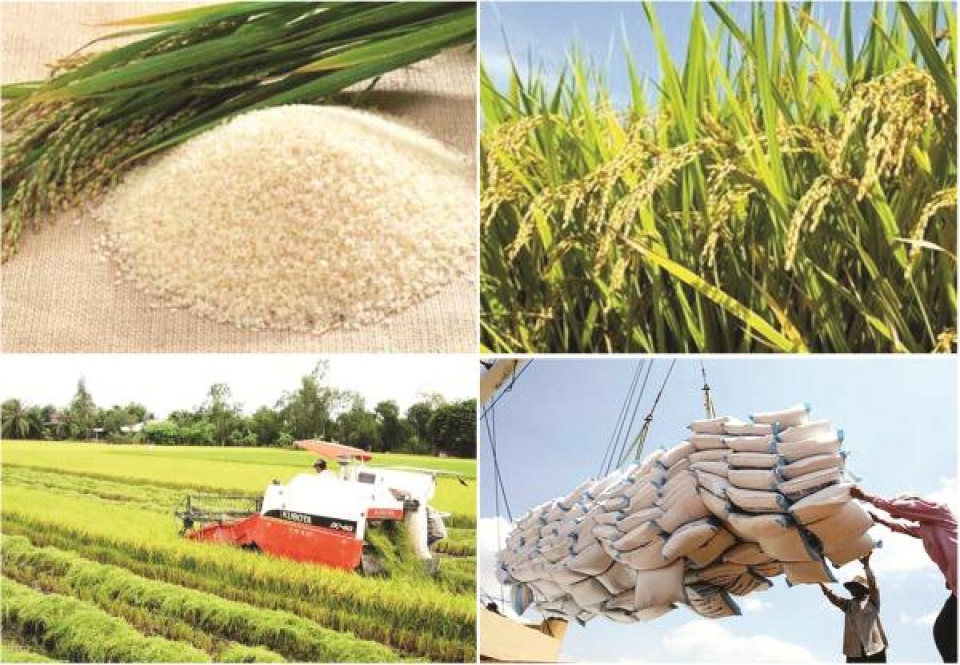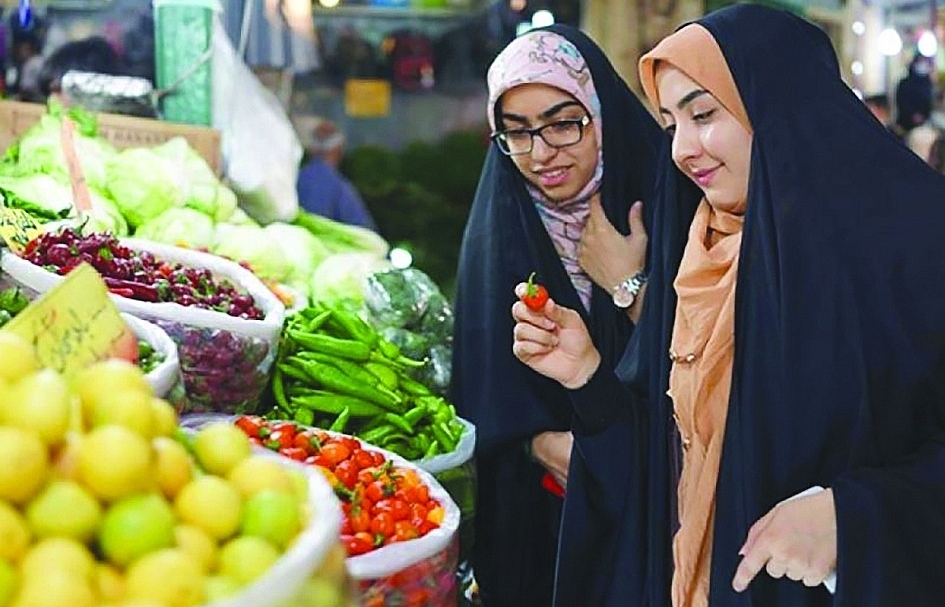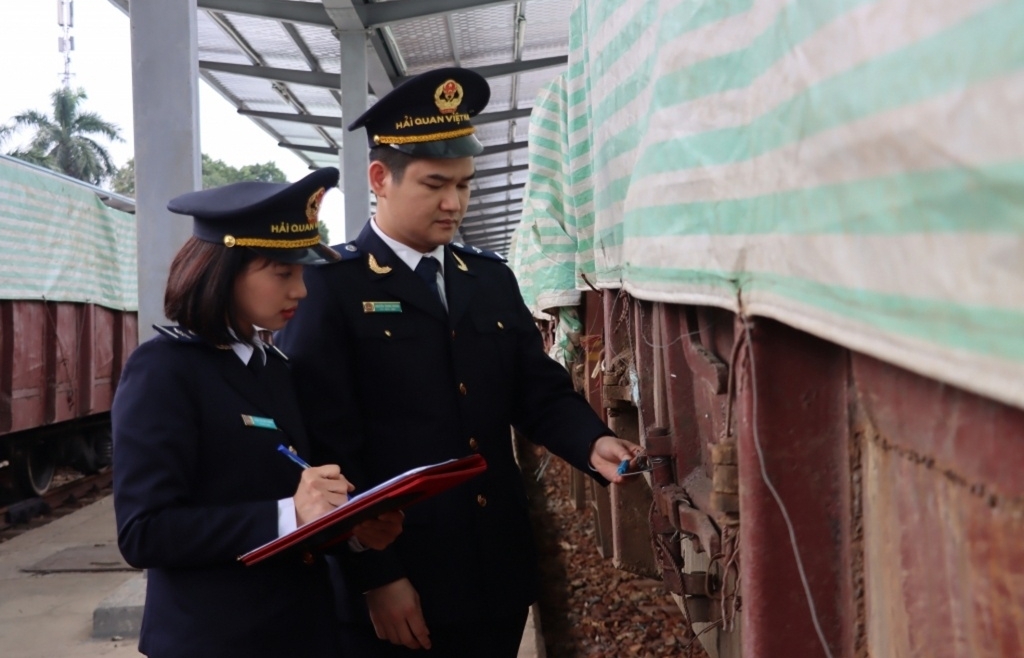Institutional barriers for Vietnamese rice removed
| Rice industry urged to change production custom | |
| Vietnamese rice export in 2016 forecast to drop |
 |
| Vietnamese rice industry is standing before the G hour of renovation. Photo: ST. |
Many obstacles
As researched by the Central Institute for Economic Management (CIEM), the value chain of the Vietnamese rice industry Vietnam is facing many challenges, including big restrictions that hindrance the growth and value increase of the rice industry. The biggest restriction is that the scale of rice production in particular and the scale of agriculture in general in Vietnam are very small, making it difficult to improve the productivity and income of farmers resulting from land policy.
According to CIEM, 85% of rice growers have less than 0.5 hectares of production area. This is also the biggest obstruction for agriculture in general. Approving with this statement, economic expert Pham Chi Lan also said that the scale of rice production in particular and the scale of agriculture in general in Vietnam are not only very small, but also much dispersed, so the productive efficiency is more restricted. The latest figures mentioned by the Prime Minister mentioned at the Rice Conference in An Giang on March 15, 2017 were that Vietnam has 14 million farmer households doing farms on 7.8 million pieces of land.
Besides, according to Dr. Dang Quang Vinh, CIEM, Vietnam's rice production is paying attention to the quantity, and is not paying attention to the quality, and the rice producers are using too many different rice varieties with different quality. Furthermore, Vietnam's rice production is using a lot of fertilizers and pesticides, and high intensity of cultivation, from 2 to 3 crops per year, therefore, the risk of land degradation and environmental pollution is very great.
The restrictions of the rice value chain have had a great impact on Vietnam's rice export. In many years, Vietnam was the third largest exporter on rice, but in 2016, Vietnam's rice export decreased in both volume and value with the corresponding figures of 25.5% and 20.5% respectively.
According to Master. Research postgraduate. Nguyen Thi Thanh Huyen, one of the main causes is the restriction in production, harvesting, processing and export chains. The small and fragmented production and the lack of large-sample fields lead to unequal rice quality. We use too many rice varieties with different quality of grain resulting in inconsistency in quality and incapability of origin identification.
Besides, the level of mechanization in the harvesting process is low leading to low quality of export rice, high production cost and high post-harvest losses. The reverse process from processing rice for export basing on inventory of raw material rice, then mixing, polishing, drying and decentralizing under export contracts, that leads to low rice quality rice and high loss and damage levels.
Also according to experts, Vietnam's rice production industry is fragmented due to lack of a land market for agriculture. This is one of five important markets (such as technology market, capital market etc.) to promote agricultural development. Currently, despite the provisions on the transfer and lease of agricultural land are already issued, in reality, there is a lack of support services as well as policies attached to the land market for agriculture, so almost the transfer or lease of land is very difficult, which makes the implementation of large-sample fields meet many obstacles.
Before the challenges of Vietnam's rice industry, recently, at the Rice Conference held in An Giang, the head of the Government said that Vietnam's rice industry is standing before the G hour of the renovation, which requires a comprehensive tectonic thinking from the institutional basis, policy and law to the operational structure, administration method and production technology in order for Vietnamese rice grains to meet consumer demand in Asia and the world, thereby bringing the best added value to Vietnamese rice farmers as well as rice companies.
Turning-point changes needed
Commenting on this issue, Dr. Nguyen Dinh Cung, Director of CIEM said that Vietnam's rice industry would not be as poorly competitive as it is now if the institutions for the rice value chain was changed ten years ago. Now is the time to change, but it is not just a few small changes that must be turning-point changes. According to Mad Pham Chi Lan, the economic expert, in order to transform the rice industry, it is necessary to change the institutions on many related fields, not just in the fields under the Ministry of Agriculture. Currently, inputs of rice production, including policies such as investment policy, import policy for agricultural supplies, agricultural extension policy, and organization of supply chain and quality control of agricultural supplies are actually causing a big loss to Vietnam’s rice industry and farmers, so it is impossible not to innovate strongly.
According to experts, the biggest barrier is still the institutions on land management, so this is an issue that needs to be changed first. Mr. Dao The Anh, Deputy Director of the Field Crops Research Institute acknowledged that in addition to protect the assets on land for farmers, the Government should promote the lease of land. “What we need to have a large area of rice cultivation is the lease of agricultural land, but now if enterprises want to hire land, they have to ask each farmer, so the transaction costs will be high and production will not effective, due to the lack of agricultural land trading floor. In order to attract enterprises, we should promote and encourage the lease of land, while ensuring the lease time to ensure the capital recovery of enterprises” suggested by Mr. Dao The Anh
For land policy on land for rice cultivation, the economic expert Pham Chi Lan stated that it is necessary to abolish the current land limit policy, including specific regulations for each area, because the fact that the areas which have less land, and high population density have immigration with increasing scale.
Relating to trade policy on rice, many experts said that it is necessary to immediately abolish the regulations that create unequal competition and push back the development of rice export in Decree 109/2010 / ND- CP on rice export business. According to expert Pham Chi Lan, it can be said that this is the worst policy on export with the reverse trend when increasing the right of State management agencies and State enterprises to raise obstacles for private enterprises and small and medium sized enterprises and farmers, also create more barriers for our country’s rice export in the context of increased competition in the world market. "The Prime Minister made a clear conclusion on the demand to revise Decree 109 and the conditions for rice export, as well as reviewed and removed the unreasonable rights of the Vietnam Food Association (VFA) through the Conference on restructuring the rice industry on March 15, 2017, so it needs to immediately and thoroughly implement these instructions, " proposed by the expert Pham Chi Lan.
Concerning this issue, Mr. Dao The Anh noted that the most urgent issue now is that we must change from the export management mechanism by volume (such as hard regulations on rice export in Decree 109) to management thinking by quality. To do so, we should firstly rebuild standards for Vietnamese rice, because the current standards are out of date and built in the 1960s and 1970s. In addition, any enterprises, which ensure the quality and sign export contracts, will be allowed to export and the quality will be decided by buyers. We should not let the situation like the situation of the organic rice production enterprises in Ca Mau province happen, which was that these enterprises did not have export licenses, they must ask for other enterprises’ export licenses to export their products.
 | China set to cut into India, Vietnam rice exports in 2017 - USDA Falling demand and overseas competition are expected to bite into Vietnam's rice exports. |
According to CIEM, if before the Decree 109 has not been issued nationwide, there were more than 200 rice exporters, there are now only more than 100 enterprises, although private enterprises are increasingly involved in the market. Due to the inadequacies of Decree 109, the rice exports now focus on State owned enterprises such as Vinafood 1, Vinafood 2 and local State owned enterprises.
| "In addition to small scale, Vietnam’s rice production is difficult due to the high level of land fragmentation. The policy on the equal sharing of the land in both quantity and quality makes each household have several pieces of land in different locations. Starting from the good purpose on equality and risk sharing, this policy raises production costs and makes difficulties for agricultural mechanization” Dr. Dang Quang Vinh, CIEM |
Related News

Regulating goods across Huu Nghi International Border Gate during peak times
19:37 | 02/11/2024 Customs

Khanh Hoa Customs reaches revenue target 1 quarter early
09:29 | 31/10/2024 Customs

3 items have a big impact on the budget revenue of Ho Chi Minh City Customs
19:38 | 02/11/2024 Customs

Import and export are expected to reach 800 billion USD
13:32 | 04/11/2024 Import-Export
Latest News

Fresh coconuts quenching new overseas markets
13:29 | 04/11/2024 Import-Export

Rice exports likely to set new record in 2024
13:25 | 04/11/2024 Import-Export

Vietnamese goods conquer halal market through trust and quality
09:57 | 04/11/2024 Import-Export

Exporters urged to have strategies to take advantage of UKVFTA for expansion
17:33 | 03/11/2024 Import-Export
More News

Fresh coconuts quenching new overseas markets
17:29 | 03/11/2024 Import-Export

Vietnam and UAE trade sees billion-dollar growth
07:15 | 03/11/2024 Import-Export

Sharing responsibility for ensuring security and safety of the supply chain
07:13 | 03/11/2024 Import-Export

Many factors affecting tuna exports in the last months of the year
19:38 | 02/11/2024 Import-Export

Vietnam still dominates Philippine rice import
19:36 | 02/11/2024 Import-Export
Vietnam cements ties with partners to engage in global semiconductor, AI industries
19:35 | 02/11/2024 Import-Export

Aquatic exports expected to rise in year-end despite challenges
19:33 | 02/11/2024 Import-Export

Trade Defense: The Key to Success for Vietnamese Businesses
10:39 | 02/11/2024 Import-Export

Lao Cai Customs sees a triple-digit surge in export-import turnover
10:37 | 02/11/2024 Import-Export
Your care

Import and export are expected to reach 800 billion USD
13:32 | 04/11/2024 Import-Export

Fresh coconuts quenching new overseas markets
13:29 | 04/11/2024 Import-Export

Rice exports likely to set new record in 2024
13:25 | 04/11/2024 Import-Export

Vietnamese goods conquer halal market through trust and quality
09:57 | 04/11/2024 Import-Export

Exporters urged to have strategies to take advantage of UKVFTA for expansion
17:33 | 03/11/2024 Import-Export





